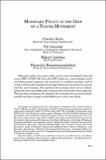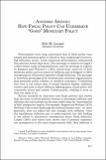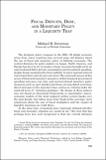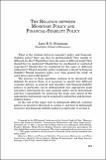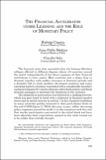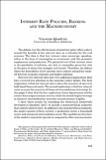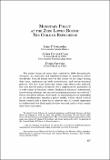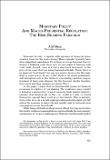Buscar
Mostrando ítems 51-60 de 102
Monetary policy in the grip of a pincer movement
Monetary policy has come under strain since the global financial crisis (GFC) of 2007–09. Once the GFC broke out central banks’ swift and determined response was essential to stabilise markets and to avoid a self-reinforcing downward spiral between the financial system and the real economy. But putting ...
Anchors aweigh: how fiscal policy can undermine 'good' monetary policy
Policymakers have long understood that if fiscal policy runs amuck and monetary policy is forced to raise seigniorage revenues big inflations result. Latin American policymakers understand this outcome better than most. This message is implicit in Cagan’s (1956) initial study of hyperinflation and the ...
Fiscal deficits debt and monetary policy in a liquidity trap
The dramatic policy response to the 2008-09 global economic crisis from many countries has revived some old debates about the use of fiscal and monetary policy in fighting recessions. The central dilemma for policy-makers in Japan North America and Europe has been to try to counter a large recession ...
The relation between monetary policy and financial-stability policy
What is the relation between monetary policy and financialstability policy? How can they be distinguished? How similar or different are they? Should they have the same or different goals? How should they be conducted? Should they be coordinated or conducted separately? Should they be conducted by the ...
The financial accelerator under learning and the role of monetary policy
The financial crisis that unraveled after the Lehman Brothers collapse affected in different degrees almost all countries around the world independently of the direct exposure of their financial institutions to toxic assets. Most countries saw a sharp drop in demand together with sudden increases in ...
Interest rate policies banking and the macroeconomy
The debate over the effectiveness of monetary policy often centers around the benefits of low interest rates as a stimulus for the real economy. The idea is that low interest rates encourage spending either in the form of consumption or investment and this promotes employment and production. The ...
Trilemmas and tradeoffs: living with financial globalization
This paper evaluates the capacity of emerging market economies (EMEs) to moderate the domestic impact of global financial and monetary forces through their own monetary policies. I present the case that those EMEs able to exploit a flexible exchange rate are far better positioned than those that devote ...
International aspects of the zero lower bound constraint
Large negative aggregate demand shocks can drive down an economy’s equilibrium real interest rate and if the central bank is committed to stabilizing inflation monetary policy may be hampered by the zero lower bound on nominal interest rates –the economy may be in a 'liquidity trap.' The policy dilemma ...
Monetary policy at the zero lower bound: the Chilean experience
The global financial crisis that started in 2008 dramatically changed the analysis and implementation of monetary policy worldwide. Central banks were at the center of the stage during that time implementing both conventional and unconventional policies. Not only were monetary policy rates drastically ...
Monetary policy and macro-prudential regulation: the risk-sharing paradigm
Economic history is replete with episodes of financial crises creating havoc for the real economy. These episodes typically have three important ingredients. First there are large financial flows to finance a bubbling asset class such as sovereigns or housing with 'safe' debt. Second there is a sharp ...

